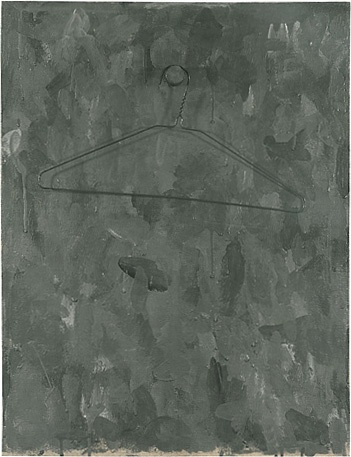Jasper Johns’s first museum show in Los Angeles, in 1965

Walter Hopps brought a Jasper Johns exhibition to the Pasadena Art Museum in early 1965. Speaking to the press, he was quoted as saying, “ Jasper Johns, while developing within the mainstream of advanced American painting, has opened new areas of literal image subject matter in his art. A major contribution of Johns has been his introduction of deceptively commonplace images which raise vital, new questions of meaning within the context of the formal, abstract art.”
The art writer for the Los Angeles Times, Art Seidenbaum, was not particularly taken with this explanation. In his report he wrote:
“We are all grotesques, I suppose.
“But watching high-income, growing-paunch people doing the Watusi and the Swim in the middle of a museum is a joke on a twist on a social comment. We live in a time of wildly affirmative denial.
“Carson McCullers, I guess, with her assorted cast of deformed character, would understand. Luis Buñuel, who once lined up some lunatics in a fierce facsimile of The Last Supper, could probably appreciate it. Henri Cartier-Bresson, managing to use his eye while maintaining his sympathies, might be able to see it with proper fairness.
“This was the background for the joke: a couple of hundred art appreciators turned out the other night for a preview of the Jasper Johns show presently decorating the Pasadena Art Museum. The majority were the better-off people in the Great society.
“There has always been a groovy paradox in the fact that our furthest-out museum should find a home in our nearest-staid community. When Marcel Duchamp, the grandfather of anything goes, came away from his chess boards to attend a handsome Pasadena show in his honor, the same crowd gave a new half-life to the Green Hotel. But this time for Johns, who helped cause pop art, the celebrators stayed in the museum proper. It was a happening happening.
“Guests began slowly, walking around staring at Johns’ use of coat hangers and beer cans and light bulbs, assuring each other. ‘What a splendid show.’ It was a refrain: great show, pass it on.
“Nothing on the walls was more peculiar than some people on the floor. This is part of today’s joke. As artists zealously work toward holding their distorted, exaggerated or painfully personal mirrors to the word, the audiences work ever harder at being all the more unusual.
“A man who used to be a child actor now swaddled in a huge fur coat, a bear rug that walks. A girl in a white suit and white stockings and white boots, a nurse registered to the motorcycle set. A small man behind huge black glasses under a neatly greased hairdo, a fly in his own ointment.
“Then, to the thwack-thump of drums and guitar, to the stimulus of champagne punch, to the delight of art historians and archivists, the audience became the show.”
Los Angeles Times (Wednesday, February 3, 1965).